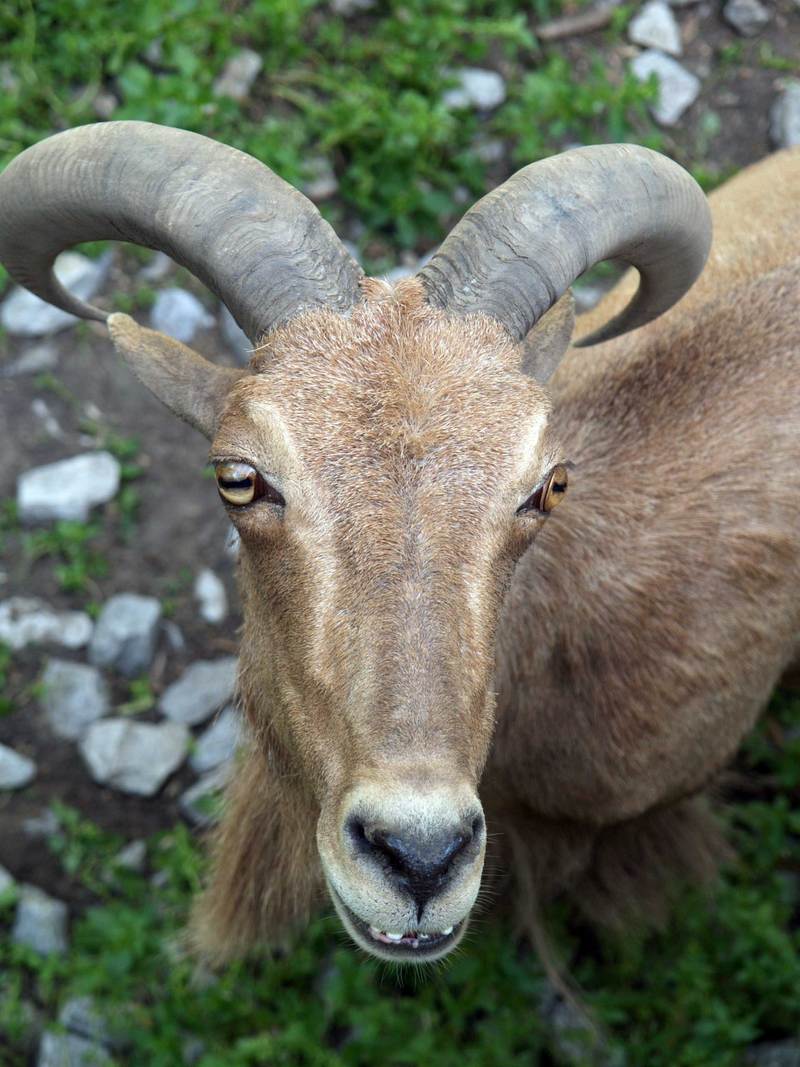|
| Query: Goat antelope | Result: 42nd of 80 | |
Barbary Sheep (Ammotragus lervia) - Wiki
| Subject: | Barbary Sheep (Ammotragus lervia) - Wiki
| |

| Resolution: 1920x2560
File Size: 362766 Bytes
Upload Date: 2007:10:19 01:37:07
|
Barbary Sheep
From Wikipedia, the free encyclopedia
[Photo] Barbary Sheep (Ammotragus lervia), Arui. Date 06/2006. Author Andrzej Barabasz (http://pl.wikipedia.org/wiki/Wikipedysta:Chepry). Copyright (C) 2006 Andrzej Barabasz
Permission is granted to copy, distribute and/or modify this document under the terms of the GNU Free Documentation License, Version 1.2 or any later version published by the Free Software Foundation; with no Invariant Sections, no Front-Cover Texts, and no Back-Cover Texts. A copy of the license is included in the section entitled "GNU Free Documentation License". |
The Barbary Sheep (Ammotragus lervia, also called Aoudad and Arui) is a species of Caprinae (goat-antelope) found in rocky mountains in North Africa. Six subspecies have been described. Although it is rare in its native North Africa, it has been introduced to North America, southern Europe and elsewhere.
Description
Barbary Sheep stand 80 to 100 cm (30 to 40 inches) tall at the shoulder and weigh 40 to 140 kg (90 to 310 lb). They are a sandy-brown color, darkening with age, with a slightly lighter underbelly and a darker line on the back. Upperparts and outer legs are uniform reddish-brown or grayish-brown. There is some shaggy hair on the throat (extending down to the chest in males) and a sparse "mane". Their horns have a triangular cross section. The horns curve outwards, backwards then inwards, and reach up to 50 cm (20 inches). The horns are smooth, but wrinkled at the base. Scientists say that the horns can grow to be about six inches long.
Subspecies
The subspecies are classified mainly according to their distribution in North Africa:
Ammotragus lervia lervia Pallas, 1777.
Ammotragus lervia ornata I. Geoffroy Saint-Hilaire, 1827.
Ammotragus lervia sahariensis Rothschild, 1913.
Ammotragus lervia blainei Rothschild, 1913.
Ammotragus lervia angusi Rothschild, 1921.
Ammotragus lervia fassini Lepri, 1930.
A. l. ornata, the Egyptian Barbary Sheep, which was considered to be extinct but recent evidence suggests it still exists.
Habitats
Barbary Sheep are found in arid mountainous areas of the Sahara where they graze and browse all available plants -- grass, bushes, lichen and acacia. They obtain all their moisture from food, but if water is available they drink and wallow in it. Barbary Sheep are crepuscular, active in the early morning and late afternoon, resting in the heat of the day. They are very agile and can jump over two metres from a stand-still. Barbary Sheep are usually solitary, and freeze in the presence of danger. Their main predators in North Africa are leopards and caracals.
Barbary sheep are found in Mauritania, Morocco, southern Algeria, northwest Chad and Sudan, and were introduced into southeastern Spain and southwestern United States (parts of Texas, New Mexico, California) and Mexico and in some parts of Africa.
Expansion to Southern Europe
The species is currently expanding in the southeastern quarter of the Iberian Peninsula according to recent field surveys (Cassinello et al., 2004). Aoudads have become common in a limited region of the south east of Spain since its introduction as a game species in Sierra Espu??a Natural Park in 1970. Its adaptability enabled it to colonise nearby areas quickly. Increasing number of Aoudads in Spanish private game estates were other centers of dispersion.
Aoudads also were introduced in La Palma Island (Canary Islands), becoming a serious threat to endemic flora. Of great conservation concern is their potential as competitors against native ungulates inhabiting the peninsula. Surveys conducted in southern Spain documented rapid colonization of new areas and established viable populations, consisting of adult males and females and the unequivocal presence of nursery groups, in the provinces of Alicante, Almer??a, Granada and Murcia. Aoudads have also spread throughout the north and centre of La Palma.
There are two main conservational concerns: the necessity to conduct detailed, reliable surveys in all potential regions where the species might expand, and the urgent need to change current game policies in order to establish reliable controls on big game estates to prevent animals from escaping.
Names
The binomial name ammotragus lervia derives from the Greek ammos (sand, referring to the sand-coloured coat) and tragos (goat). Lervia derives from the wild sheep of northern Africa described as "Lerwee" by Rev. T. Shaw in his "Travels and Observations" about parts of Barbary and Levant.
Aoudad (pronounced "aOO-dad" or "OW-dad") is the name for this sheep used by the Berbers, a North African tribe.
http://en.wikipedia.org/wiki/Barbary_Sheep
| The text in this page is based on the copyrighted Wikipedia article shown in above URL. It is used under the GNU Free Documentation License. You may redistribute it, verbatim or modified, providing that you comply with the terms of the GFDL. |
|
Comments |
|---|
| | Guest |
|
Scientific Name: Ammotragus lervia (Pallas, 1777)
Common Names:
English – Aoudad, Uaddan, Barbary Sheep
French – Mouflon À Manchettes |
^o^
Animal Pictures Archive for smart phones
^o^
|
|
|